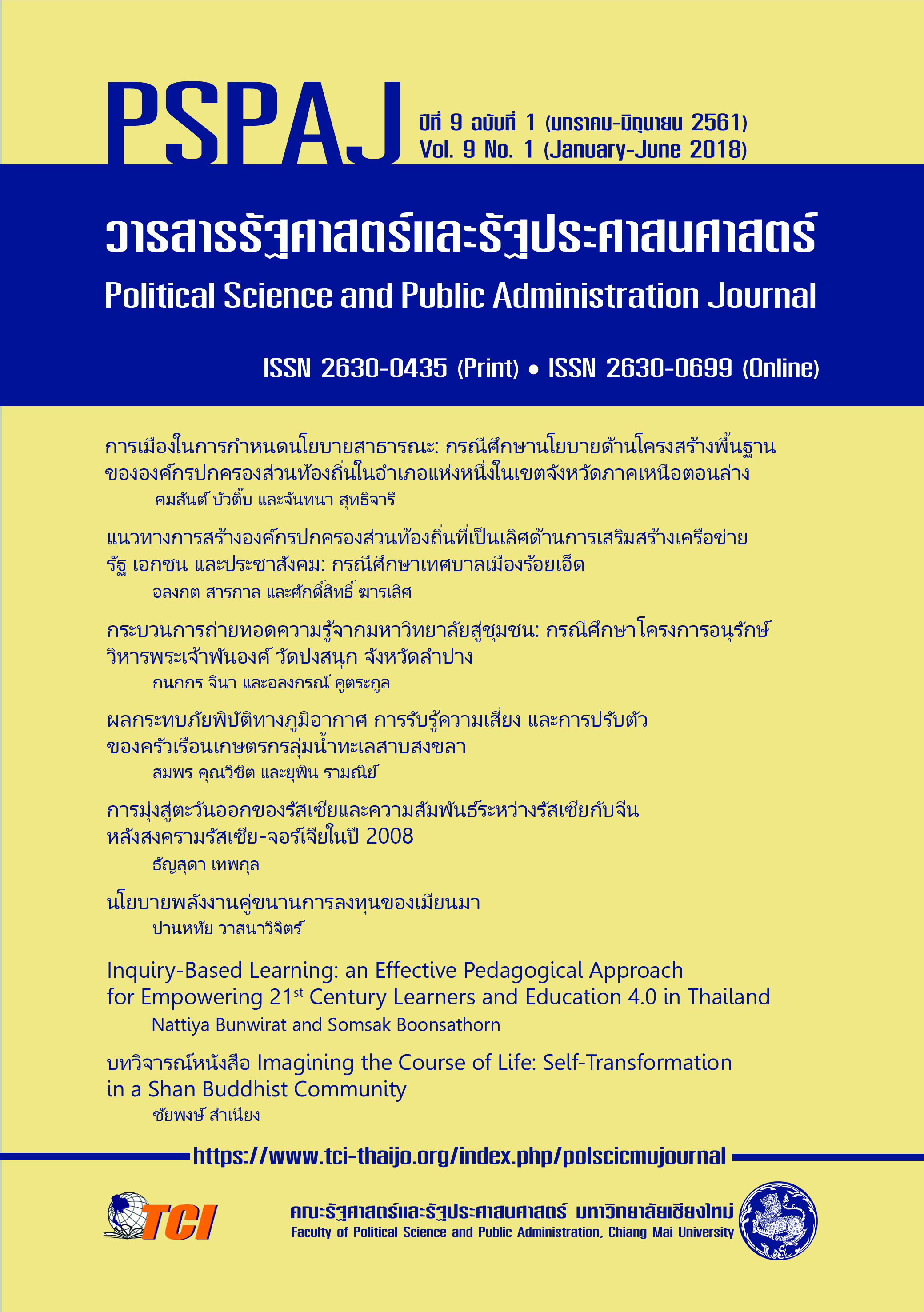Russia’s Eastward Turn and Relationship between Russia and China after Russo-Georgian War in 2008
Main Article Content
Abstract
This article is a study on Russia’s eastward turn during its worsening relationship with the western countries since the 2008 Georgia War. It is also related to the western economic and financial crisis including Ukraine Crisis which led to annexation of Crimea by Russia. These situations contributed to Russia’s moving far from the west and getting close to the east in order to seek partners as to avoid western pressure and sanction and also to construct a new power that is independent from the west. In principle, Russia’s Eastward Turn is supposed to move far from the west to the east of Moscow or at least turn to what is not Western–centric world–view. However, in practice, the attempt seemed to work well with China which can be obviously seen from the fact that their relationship was improved and their strategic partnership progressed to be deep and comprehensive. As for the other eastern actors, the western condition is the main obstacle that is difficult to solve compared to China. So, ‘turn to the east’, in the other word, is ‘pivot to China’ where its goal is to create a new power countering the west and use their familiarity searching for new opportunities in Asia – Pacific region through Russia Far East.
Article Details
- เนื้อหาและข้อมูลที่ลงตีพิมพ์ในวารสารรัฐศาสตร์และรัฐประศาสนศาสตร์ถือเป็นข้อคิดเห็นและความรับผิดชอบของผู้เขียนบทความโดยตรง ซึ่งกองบรรณาธิการวารสารรัฐศาสตร์และรัฐประศาสนศาสตร์ ไม่จำเป็นต้องเห็นด้วย หรือร่วมรับผิดชอบใดๆ
- บทความและข้อมูล ที่ได้รับการตีพิมพ์ในวารสารรัฐศาสตร์และรัฐประศาสนศาสตร์ ถือเป็นลิขสิทธิ์ของวารสาร หากบุคคลหรือหน่วยงานใดต้องการนำข้อมูลไปใช้ประโยชน์ในทางวิชาการ ขอให้อ้างอิงแหล่งที่มาด้วย
References
มานะ ผุยเจริญ. (2544). รัสเซีย ยุคปูติน. กรุงเทพฯ: ศูนย์ศึกษาการระหว่างประเทศ มหาวิทยาลัยธรรมศาสตร์.
รมย์ ภิรมนตรี. (2556). วลาดิมีร์ ปูติน: ประธานาธิบดีสมัยที่ 3 (1). วารสารรัสเซียศึกษา, 4(1-2), น. 1-23.
ภาษาอังกฤษ
Bhavna, D. (2016). Russia’s Asia Pivot: Engaging the Russia Far East, China and Southeast Asia. RSIS working paper, (297), pp. 1-17.
Bloomberg. (2018). Company Overview of Russia-China Investment Fund,” Retrieved February 3, 2017, from https://tinyurl.com/y77rkm79
Courtesy Munich Conference on Security Policy. (2007). Putin's Prepared Remarks at 43rd Munich Conference on Security Policy. Retrieved November 11, 2016, from https://tinyurl.com/ykdrpbt
Donaldson, R. H. & Nogee, J. L. (2009). The foreign policy of Russia: Changing systems, enduring interests. Armonk, NY: M.E.Sharpe.
Fortescue, S. (2016). Russia's “turn to the east”: a study in policy making. Post-Soviet Affairs, 32(5), pp. 423-454.
Gabuev, A. (2015). A “soft alliance”? Russia – China Relations after the Ukraine Crisis. ECFR (The European Council on Foreign Relations) Retrieved May 27, 2017, from https://tinyurl.com/ycc7mcek
Haring, M. & Cecire, M. (2013). Why the Color Revolutions Failed. Foreign Policy. Retrieved April 10, 2018, from https://tinyurl.com/zdwc8sx
Jakobson, L., Holtom, P., Knox D., & Peng, J. (2011). China’s energy and security relations with Russia: Hopes, Frustrations and Uncertainties. SIPRI Policy Paper, (29), Stockholme International Peace Research Institute.
Kaczmarski, M. (2015). Russia-China relations in the post-crisis international order. Bingdon, Oxon; New York, NY: Routledge.
Kim Younkyoo & Blank, S. (2013). Rethinking Russo-Chinese Relations in Asia: Beyond Russia’s Chinese Dilemma. China: An International Journal, 11(3), pp. 136-148.
Klein, M. & Westphal, K. (2016). Russia: Turn to China?. SWP Comments. Retrieved August 24, 2016, from https://tinyurl.com/y8al4x7h
Korolev, Alexander. (2016). Russia’s Reorientation to Asia: Causes and Strategic Implications. Pacific Affairs, 89(1), pp. 53-73.
Leichtova, M. (2014). Misunderstanding Russia: Russian foreign policy and the West. Burlington, VT: Ashgate.
Lo, B. (2014). Russia’s Eastern Direction–Distinguishing the Real from the Virtual. Russie.Nei.Visions No.17, pp. 3-32.
Lo, B, & Rothman, A. (2006). China and Russia: Common Interests, Contrasting Perceptions Asia Pacific Strategy. Asian Geopolitics Special Report. Retrieved April 16, 2015, from www.clsa.com
Mankoff, J. (2009). Russian foreign policy: The return of great power politics. Lanham, MD: Rowman & Littlefield.
Mearsheimer, J. (2014). The tragedy of great power politics. New York: W.W.Norton.
Omelicheva, M. (2013). Russian Foreign Policy: A Quest for Great Power Status in a Multipolar World. In Beasley, R. K., Kaarbo, J., Lantis, J. S., & Snarr, M. T. (Eds.). Foreign Policy in Comparative Perspective: Domestic and International Influences on State Behavior. Los Angeles: SAGE Publications, Inc.
Presidential Address to the Federal Assembly. (2013). Vladimir Putin delivered the annual Presidential Address to the Federal Assembly. Retrieved October 28, 2016, from https://tinyurl.com/y8c75spe
Rangsimaporn Paradorn. (2006). Interpretations of Eurasianism: Justifying Russia's Role in East Asia. Europe-Asia Studies, 58(3), pp. 371-389.
Rodkiewicz, W. (2014). The Turn to the east: the flawed diversification of Russia foreign policy. Point of View, (44), pp. 5-35.
Russia-China Investment Fund (RCIF). (2018). Russia - China Trade. Retrieved February 3, 2017, from https://tinyurl.com/y8t23lco
Russian National Committee of the Council for Security Cooperation in Asia Pacific (CSCAP). (2010). Going East: Russia’s Asia-Pacific Strategy. Retrieved June 21, 2016, from https://tinyurl.com/y9kg56jo
Russia Today. (2012). Russia and the changing world. Retrieved June 21, 2016, from https://on.rt.com/0shuuy
Stats APEC. (n.d.). Bilateral Linkages Database. Retrieved June 21, 2016, from https://tinyurl.com/j8j478z
Stent, A. (2014). The Limits of partnership: U.S.-Russian relations in the twenty-first century. Princeton, New Jersey: Princeton University.
Storey, I. (2015). What Russia’s “Turn to the East” Means for Southeast Asia. ISEAS Perspective, (67), pp. 1-10.
Sussex, M. (2015). Russia’s Asia rebalance. Lowy Institution for International Policy. Retrieved November 8, 2016, from https://www.lowyinstitute.org
Trenin, D. (2006). Russia leaves the west. Foreign Affairs, 85(4), pp. 87-96.
______. (2012). True Partners? How Russia and China see each other. London: The centre for European Reform.
______. (2014). Gas Deal Entails China–Russia Strategic Depth. Global Times. Retrieved November 6, 2017, from https://tinyurl.com/y9smrc4t
______. (2015). From Greater Europe to Greater Asia? The Sino – Russian Entente. Carnegie Endowment for International Peace. Retrieved October 28, 2016, from https://tinyurl.com/ybnusced

